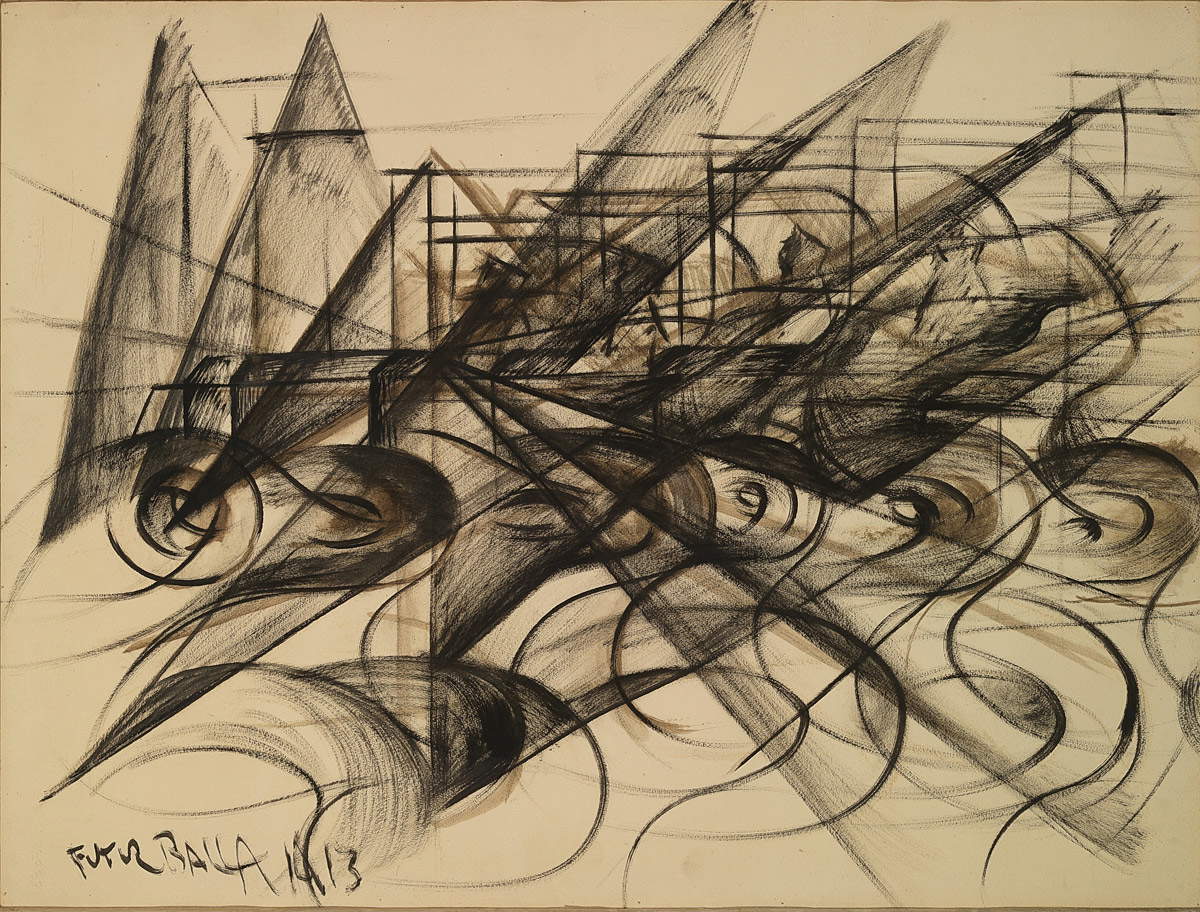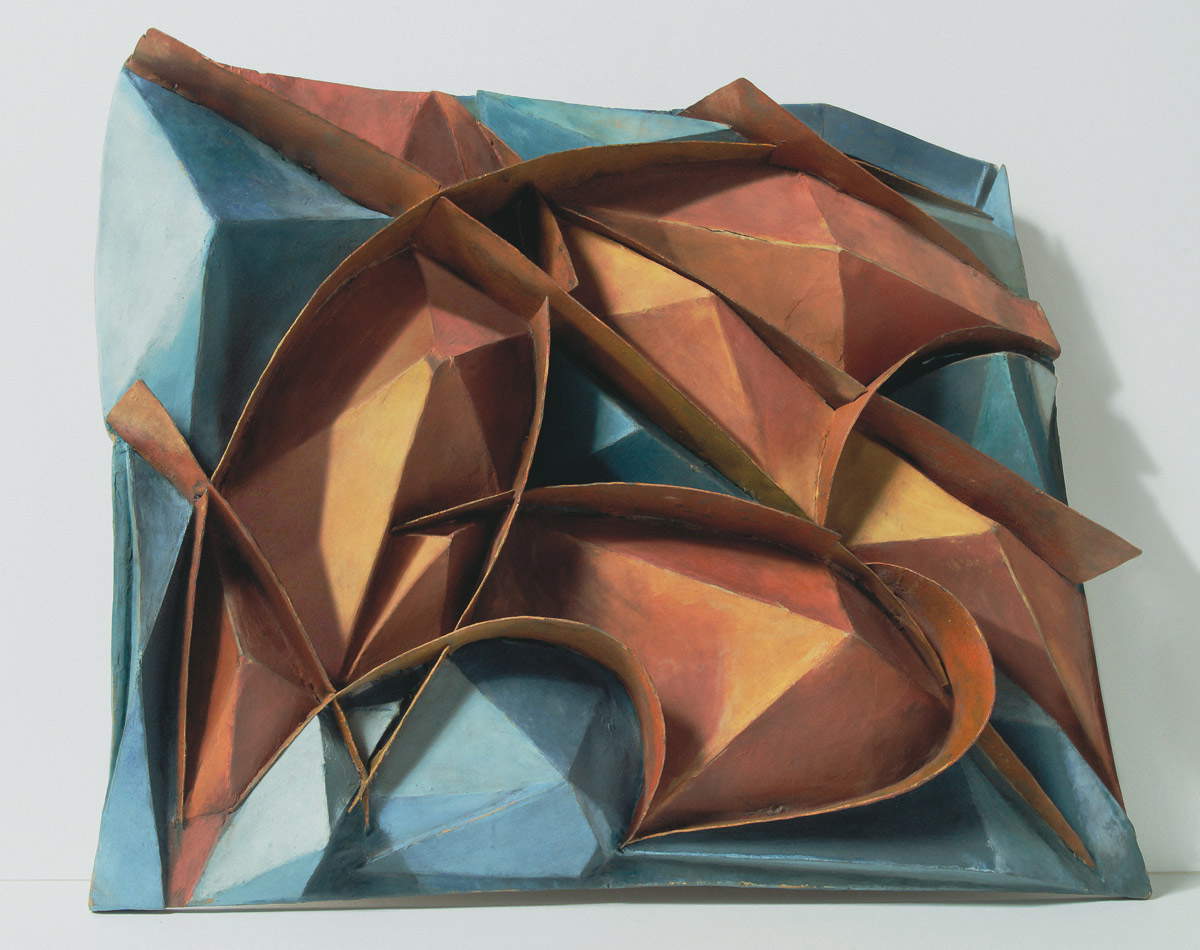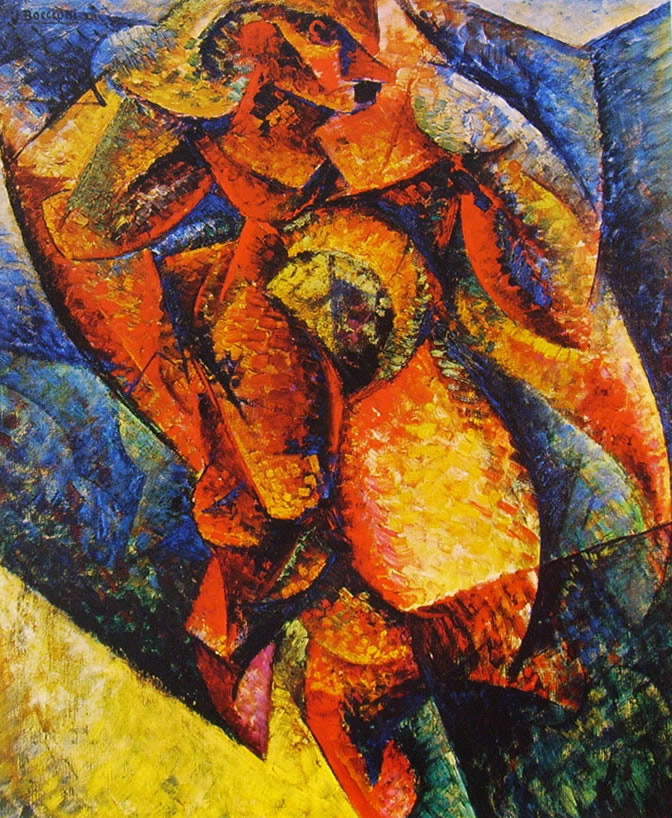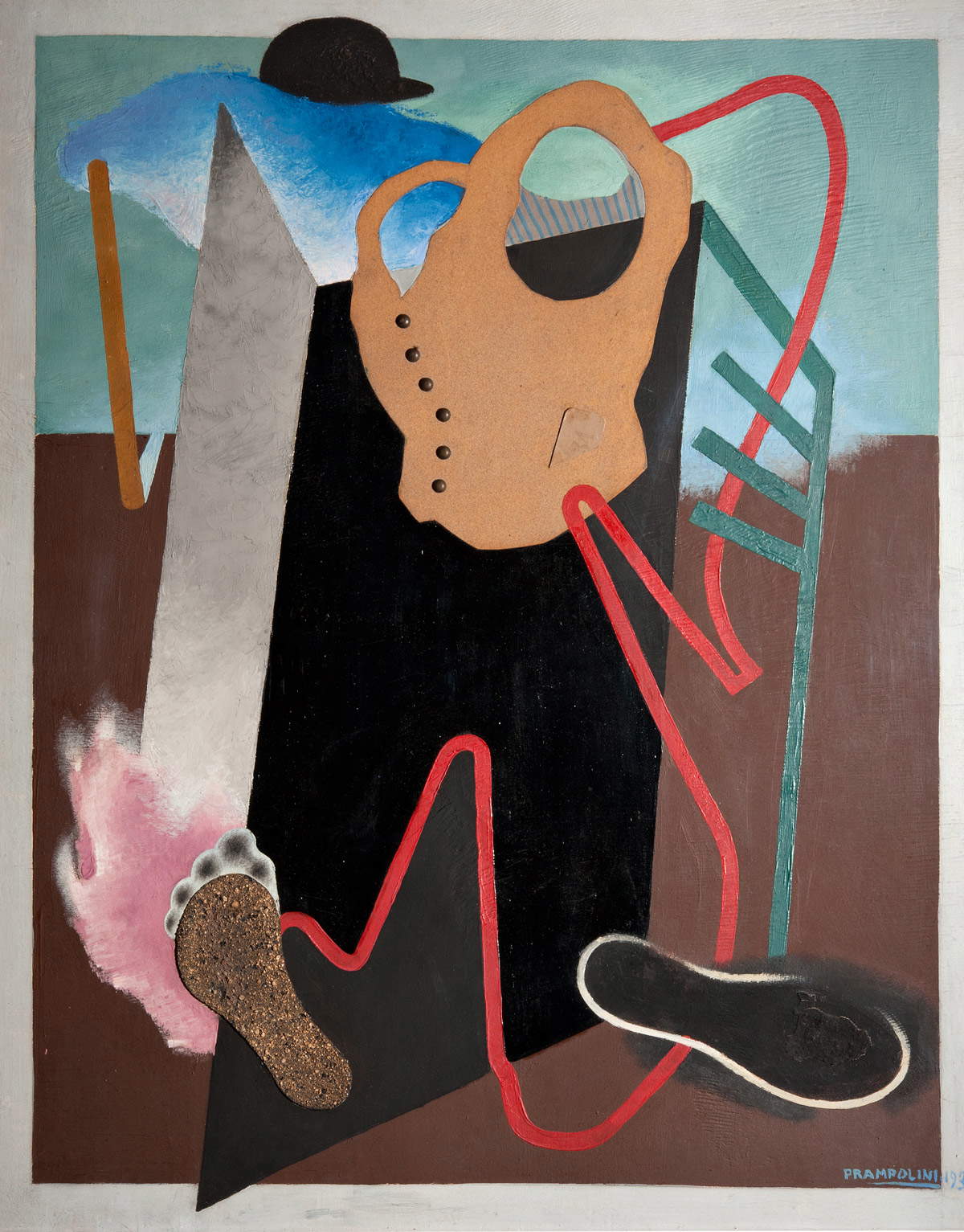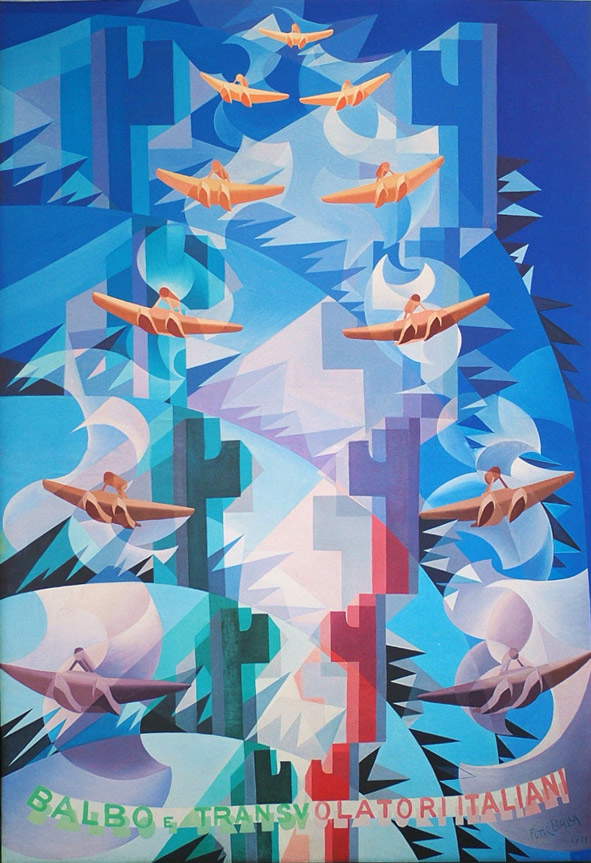by Redazione , published on 12/10/2019
Categories:
Exhibitions
/ Disclaimer
From Oct. 11, 2019 to Feb. 9, 2020, Palazzo Blu in Pisa is hosting Futurism, an exhibition entirely dedicated to futurism.
From October 11, 2019 to February 9, 2020, Palazzo Blu in Pisa hosts Futurismo, an exhibition entirely dedicated to the movement that changed Italian art in the early 20th century. Starting from the Divisionist anticipations and the milestone date of February 20, 1909, when Filippo Tommaso Marinetti published the Founding Manifesto of Futurism in Le Figaro in Paris, the exhibition, curated by Ada Masoero intends to retrace the most significant peaks of Futurism through more than one hundred works (including paintings, drawings, sculptures, objects, toys, and art projects). Not only that: the exhibition also intends to prove how the greatest among the Futurist artists knew how to remain faithful to the theoretical reflections enunciated in the manifestos, translating them into disruptive, innovative and extraordinarily artistically happy images.
For this reason, each work has been chosen for quality but also (and above all) for its adherence to the movement’s founding theoretical points. And of the many visual artists who, over time, joined futurism, only the signers of the manifestos examined have been deliberately included. There are only two exceptions to the rule: one in the opening, with Rougena Zatková’s spectacular portrait of Marinetti , perhaps the most faithful to the founder’s volcanic temperament, and one in the closing, with Before the Parachute Opens the work by Tullio Crali (from 1939) chosen as the cover image for the catalog of the major exhibition Italian Futurism 1909-1944. Reconstructing the Universe, curated by Vivien Greene in 2014 for the Solomon Guggenheim Museum in New York, with which the museum paid tribute to Futurism, recognizing it as a role of excellence among the other great European avant-gardes of the early 20th century. The itinerary is compltated by the works of the great Futurist artists: Umberto Boccioni, Carlo Carrà, Luigi Russolo, Giacomo Balla, Gino Severini, Fortunato Depero, Gerardo Dottori, Enrico Prampolini and others.
The itinerary is opened by the Divisionist beginnings common to the five “future Futurists” (Umberto Boccioni, Carlo Carrà, Luigi Russolo, Giacomo Balla, Gino Severini. Divided into sections each entitled to a manifesto, the exhibition then traverses 30 years of Futurist art, moving from 1910, when the two pictorial manifestos signed by the young “founding fathers” came out. By Umberto Boccioni, Carlo Carrà, Luigi Russolo, Giacomo Balla, and Gino Severini, numerous masterpieces clearly inspired by those two texts are displayed. Immediately following, visual transcriptions of the Manifesto of Futurist Sculpture, 1912, drafted by Boccioni alone after his trip to Paris that year, are explored. Then come into play the “words in freedom,” whose principles were formulated by Filippo Tommaso Marinetti in 1912, in the Technical Manifesto of Futurist Literature, and the new architectural models, dictated in 1914 by Antonio Sant’Elia in the text L’architettura futurista, illustrated by his magnificent (and “prophetic”) works, followed by the “war” works in support of Futurist interventionism in the Great War (Futurist Manifesto Synthesis of War, 1914). With Giacomo Balla and Fortunato Depero’s Futurist Reconstruction of the Universe (1915), we see the two artists’ new desire to spread the formal models of Futurism over the entire human experience, in a drive for innovation unknown to other European avant-gardes. Illustrating it are paintings, sculptures, objects, sketches, and toys made by the two authors. Then enters L’arte meccanica (1922) a document signed by Enrico Prampolini, Vinicio Paladini, and Ivo Pannaggi, which connoted with its geometric and “industrial” models the visual art of the entire decade, while the farewell is entrusted to the Manifesto dell’Aeropittura (1931) signed by Marinetti with Balla, Benedetta (Cappa Marinetti), Depero, Dottori, Fillia, Prampolini, Somenzi, and Tato, who throughout the 1930s inspired evocative and spectacular works, displayed here on the upper floor.
The exhibition, organized by Fondazione Palazzo Blu together with MondoMostre and sponsored by the Region of Tuscany and the City of Pisa, was made possible by the quality and quantity of the lenders, no fewer than 29, including the National Gallery of Modern and Contemporary Art in Rome, with nine works; the Museo del Novecento and GAM in Milan, with 16 works; the Castello Sforzesco in Milan (Civico Gabinetto dei Disegni and “Achille Bertarelli” Print Collection, with ten works); the Mart in Rovereto, with as many as 21 works; the Caproni Museum in Trento, with two works; and other important public and private collections.
“There have been several exhibitions on futurism, starting with the centenary one held in Milan in 2009, so it was a matter of trying to find a path that was not too worn,” explains curator Ada Masoero. “I therefore thought of giving voice to the artists themselves, resorting to their texts, because Futurism was also the only great European avant-garde, in an age in which many avant-gardes flourished, that had the shrewdness, thanks to the constant presence of Marinetti, to lay the theoretical foundations to which to adhere in the moment in artistic creation. And this was not only for the visual arts, but also for literature, theater, dance, and the decorative arts. The futurists wrote their foundations in manifestos that were distributed in very high print runs (up to 300,000 copies) in cities.The futurists’ dream was to closely connect art and life, to involve everyone, the crowd (and not just a few refined aesthetes), and to redraw the everyday horizon with the principles of futurism. Futurism was a very broad and very articulate system of thought, and it found a way to express itself with works of the highest level. I therefore cared about giving voice to the artists and this specificity of futurism: the posters therefore became the red thread that sews the exhibition together.”
“After almost a decade dedicated to the great personalities of 20th century painting,” says Cosimo Bracci Torsi, president of Fondazione Palazzo Blu, "with Futurism Palazzo Blu continues the cycle dedicated to avant-garde movements, which began last year with Surrealism. Loans from the Galleria Nazionale d’Arte Moderna in Rome, the Museo del 900, GAM and Castello Sforzesco in Milan, Mart in Rovereto, Museo Caproni in Trento and numerous private collectors have made it possible to collect fundamental documents and works by the great protagonists of the movement such as Marinetti, Balla, Boccioni, Carrà, Depero, Severini and Sant’Elia, among others. With more than one hundred works, Ada Masoero has constructed an extraordinary itinerary that illustrates the breadth of the fields in which Futurism operated, from painting, sculpture and architecture to the applied art of utilitarian objects and advertising, and its ambition to build a true system of thought."
“An exhibition that in some way is linked to the city,” stresses Pisa Mayor Michele Conti, “because some of the Futurists had important contacts with Pisa in those years: Marinetti himself had a passage at the Teatro Rossi, where there was an evening dedicated to Futurism and which ended with a vegetable toss, reasoning that according to Marinetti the evening was perfectly successful. At the time they were considered extravagant revolutionaries, but the Futurists gave birth to an important period in the history of the 20th century. The Palazzo Blu exhibitions are an important economic driver for Pisa, because they make it possible to attract intelligent tourism and to rediscover a part of the city, that of the Lungarni, which until a few years ago was somewhat forgotten. The presence of high-level exhibitions like this one certainly helps a lot the whole tourist mechanism of the city.”
“We are inaugurating an extraordinary and impeccably conceived exhibition,” comments Thomas Salomon, scientific director of MondoMostre: “Futurism is particularly interesting is because an Italian avant-garde movement and it is important to turn our attention not only abroad, as was done last year with the exhibition on surrealism, but also to the movements that developed in our country. There are more than one hundred works from thirty different lenders in the exhibition, and the quality is typical of a national, if not international, exhibition.”
For all information about the exhibition you can visit the Palazzo Blu website. Below are some images of works in the exhibition.
 |
| Giacomo Balla, Automobile + Speed + Light (1913 - 1914; watercolor and sepia on paper, 67 x 88.5 cm; Milan, Museo del Novecento) © Giacomo Balla, by SIAE 2019 |
 |
| Giacomo Balla, Colored Plastic Complex of Noise + Speed (ca. 1914; wood, cardboard, and oil-colored tin foil on wood, 52 x 60 x 7 cm; Private collection). Courtesy Futur-ism, Rome, Italy © Giacomo Balla, by SIAE 2019 |
 |
| Giacomo Balla, Pessimism and Optimism (1923; oil on canvas, 115 x 176 cm; Rome, National Gallery of Modern and Contemporary Art) © Giacomo Balla, by SIAE 2019 |
 |
| Umberto Boccioni, Charge of the Lancers (1915; tempera and collage on paper glued to canvas, 33.4 x 50.3 cm; Milan, Museo del Novecento) © Umberto Boccioni, by SIAE 2019 |
 |
| Umberto Boccioni, Human Body (Dynamism) (1913; oil on canvas, 80 x 65 cm; Milan, Museo del Novecento) © Umberto Boccioni, by SIAE 2019 |
 |
| Fortunato Depero, Al teatro dei piccoli / Balli plastici (1918; tempera on canvas, 99.5 x 73.5 cm; Private collection). courtesy Futur-ism, Rome, Italy © Fortunato Depero, by SIAE 2019 |
 |
| Gino Severini, The Bus (1913; oil on canvas, 57 x 73 cm; Milan, Museo del Novecento) © Gino Severini, by SIAE 2019 |
 |
| Enrico Prampolini, The Everyday Automaton (1930; oil and collage on panel, 100 x 80 cm; Rome, National Gallery of Modern and Contemporary Art) |
 |
| Giacomo Balla, Celestial Metallic Airplane (Balbo and Italian Flyers) (1931; oil on plywood, 280 x 150 cm; Rome, Aeronautica Militare, Museo Storico) © Giacomo Balla, by SIAE 2019 |
 |
| Umberto Boccioni, Development of a Bottle in Space (1912; bronze, 38 x 59 x 32 cm; Milan, Museo del Novecento) © Umberto Boccioni, by SIAE 2019 |
 |
| Pisa, at Palazzo Blu the futurists' masterpieces in an exhibition that rereads them through their manifestos |
Warning: the translation into English of the original Italian article was created using automatic tools.
We undertake to review all articles, but we do not guarantee the total absence of inaccuracies in the translation due to the program. You can
find the original by clicking on the ITA button. If you find any mistake,please contact us.
